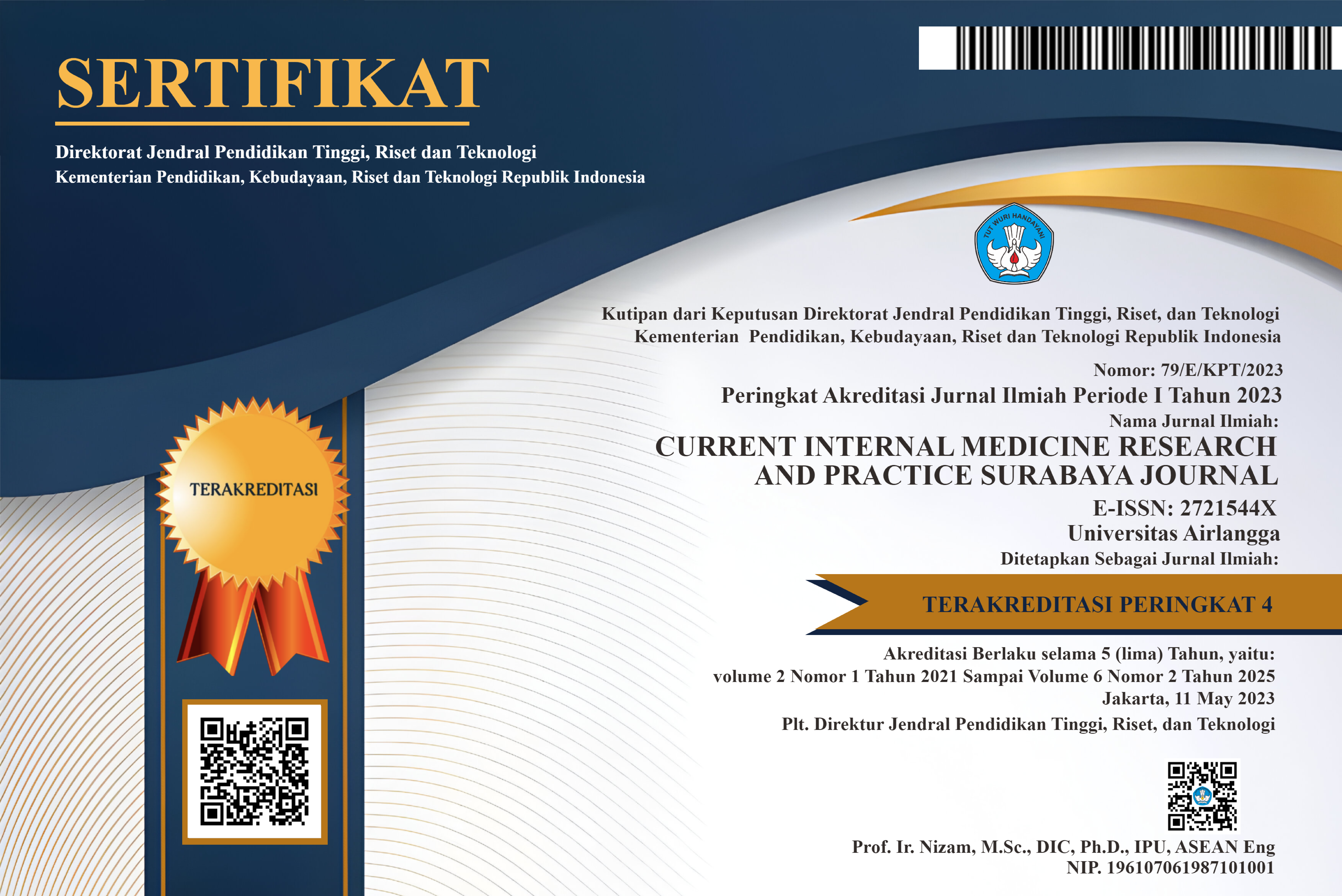Clinical and Demographic Profiling of Patients with Spondyloarthritis and Its Association with Disease Activity in a Tertiary Hospital in Surabaya, Indonesia
Downloads
Introduction: The assessment of disease activity is crucial for effectively managing chronic diseases like spondyloarthritis (SpA). Establishing the relationship between disease activity, demographic, and clinical factors is essential for better disease management. This study aimed to delve into the demographic and clinical characteristics of patients at Dr. Soetomo General Academic Hospital, a tertiary hospital in Surabaya, Indonesia, contributing to a comprehensive understanding of SpA occurrences in Surabaya.
Methods: Data were obtained from 38 SpA patients' data classified using ASAS 2009 criteria at Dr. Soetomo General Academic Hospital, excluding individuals with SLE, gout, RA, and septic arthritis. Disease activity was measured using ASDAS-CRP. Association analysis between disease activity, clinical parameters, and demographics was conducted using Mann-Withney U test and Spearman correlation test.
Results: Results indicated a male-to-female ratio of 8:30, with patients having a median age of 48 (95% CI: 41-53) and most of the patients had a senior high school education (42.11%). The patients exhibited a mean BMI of 25.19 ± 3.77, a median disease duration of 8.5 (95% CI: 5-10) years, and a median CRP value of 0.2 (95% CI: 0.1-0.5) mg/dL. The majority displayed moderate disease activity, with a median ASDAS-CRP score of 2 (95% CI: 1.5-2.7). Interestingly, no significant correlation was found between disease activity using ASDAS-CRP and the demographic or clinical parameters studied.
Conclusion: Disease activities were found not to have correlations with the demography and clinical parameters of patients with SpA from Dr. Soetomo General Academic Hospital in Surabaya, Indonesia. This emphasizes the necessity for further research to comprehend the intricate relationship between disease activity and diverse influencing factors.
Bakirci S, Dabague J, Eder L, McGonagle D, Aydin SZ. 2019. The role of obesity on inflammation and damage in spondyloarthritis: a systematic literature review on body mass index and imaging. Clinical and Experimental Rheumatology 38(1):144–148.
Bandinelli F, Salvadorini G, Sedie AD, Riente L, Bombardieri S, Matucci-Cerinic M. 2015. Impact of gender, work, and clinical presentation on diagnostic delay in Italian patients with primary ankylosing spondylitis. Clinical Rheumatology 35(2):473–478. https://doi.org/10.1007/S10067-015-3005-Z.
Berland M, Meslier V, Ibraim SM, et al. 2023. Both disease activity and HLA–B27 status are associated with gut microbiome dysbiosis in spondyloarthritis patients. Arthritis and Rheumatology 75(1):41–52. https://doi.org/10.1002/art.42289.
Berthelot JM, Darrieutort-Laffite C, Trang C, Maugars Y, Le Goff B. 2021. Contribution of mycobiota to the pathogenesis of spondyloarthritis. Joint Bone Spine 88(6):105245. https://doi.org/10.1016/J.JBSPIN.2021.105245.
Chimenti MS, Alten R, D'Agostino MA, et al. 2021. Sex-associated and gender-associated differences in the diagnosis and management of axial spondyloarthritis: addressing the unmet needs of female patients. RMD Open 7(3):e001681–e001681. https://doi.org/10.1136/RMDOPEN-2021-001681.
Chimenti MS, Conigliaro P, Navarini L, Martina FM, et al. 2019. Demographic and clinical differences between ankylosing spondylitis and non-radiographic axial spondyloarthritis: results from a multicentre retrospective study in the Lazio region of Italy. Clinical and Experimental Rheumatology 38(1):88–93.
Citera G, Bautista-Molano W, Peláez-Ballestas I, et al. 2021. Prevalence, demographics, and clinical characteristics of Latin American patients with spondyloarthritis. Advances in Rheumatology 61(1):1–12. https://doi.org/10.1186/s42358-020-00161-5.
Dougados M and Baeten D. 2011. Spondyloarthritis. The Lancet 377(9783):2127–2137. https://doi.org/10.1016/S0140-6736(11)60071-8.
Dougados M, Gueguen A, Nakache JP, Velicitat P, Zeidler H, et al. 1999. Clinical relevance of C-reactive protein in axial involvement of ankylosing spondylitis. The Journal of Rheumatology 26(4):971–974.
Fatica M, D'Antonio A, Novelli L, et al. 2023. How has molecular biology enhanced our undertaking of axSpA and its management. Current Rheumatology Reports, 25(1):12-33. https://doi.org/10.1007/S11926-022-01092-4.
Gremese E, Bernardi S, Bonazza S, Nowik M, et al. 2014. Body weight, gender and response to TNF-α blockers in axial spondyloarthritis. Rheumatology (Oxford, England), 53(5):875–881. https://doi.org/10.1093/RHEUMATOLOGY/KET433.
Kamo K, Shuto T, Haraguchi A. 2014. Prevalence of spondyloarthritis symptom in inflammatory bowel disease patients: A questionnaire survey. Modern Rheumatology 25(3):435–437. https://doi.org/10.3109/14397595.2014.964925.
Kennedy LG, Will R, Calin A. 1993. Sex ratio in the spondyloarthropathies and its relationship to phenotypic expression, mode of inheritance and age at onset. The Journal of Rheumatology 20(11):1900–1904.
Landewé R, Nurminen T, Davies O, Baeten D. 2018. A single determination of C-reactive protein does not suffice to declare a patient with a diagnosis of axial spondyloarthritis "CRP-negative”. Arthritis Research & Therapy 20(1):209–209. https://doi.org/10.1186/S13075-018-1707-8.
Malakar A, Kakati S, Barman B, Dutta A. 2020. Clinical presentation and subtypes of spondyloarthritis patients in North East India. The Egyptian Rheumatologist 42(4):271–274. https://doi.org/10.1016/J.EJR.2020.08.003.
Monti S, Klersy C, Gorla R, et al. 2017. Factors influencing the choice of first- and second-line biologic therapy for the treatment of rheumatoid arthritis: real-life data from the Italian LORHEN Registry. Clinical Rheumatology 36(4):753–761. doi: 10.1007/s10067-016-3528-y.
Poddubnyy DA, Rudwaleit M, Listing J, Braun J, Sieper J. 2010. Comparison of a high sensitivity and standard C reactive protein measurement in patients with ankylosing spondylitis and non-radiographic axial spondyloarthritis. Annals of the Rheumatic Diseases 69(7):1338–1341. https://doi.org/10.1136/ARD.2009.120139.
Ramiro S, Tubergen AM, van Heijde D, van der Stolwijk C, et al. 2013. Higher disease activity leads to more damage in the early phases of ankylosing spondylitis: 12-year data from the OASIS cohort. Arthritis and Rheumatism 65:S1215–S1216.
Rohde G, Berg KH, Prí¸ven A, Haugeberg G. 2017. The relationship between demographic- and disease-related variables and health-related quality of life in patients with axial spondyloarthritis. BMC Musculoskeletal Disorders 18(1). https://doi.org/10.1186/S12891-017-1693-Z.
Sharip A and Kunz J. 2020. Understanding the pathogenesis of spondyloarthritis. Biomolecules 10(10):1–20. https://doi.org/10.3390/BIOM10101461.
Sieper J, Rudwaleit M, Baraliakos X, Brandt J, et al. 2009. The Assessment of SpondyloArthritis international Society (ASAS) handbook: a guide to assess spondyloarthritis. Annals of the Rheumatic Diseases 68(Suppl 2):ii1–ii44. https://doi.org/10.1136/ARD.2008.104018.
Strand V, Rao SA, Shillington AC, Cifaldi MA, et al. 2013. Prevalence of axial spondyloarthritis in united states rheumatology practices: Assessment of spondyloarthritis international society criteria versus rheumatology expert clinical diagnosis. Arthritis Care and Research 65(8):1299–1306. https://doi.org/10.1002/ACR.21994.
Wendling D, Claudepierre P, Prati C. 2013. Early diagnosis and management are crucial in spondyloarthritis. Joint Bone Spine 80(6):582–585. https://doi.org/10.1016/J.JBSPIN.2013.03.003.
Xu M, Lin Z, Deng X, et al. 2011. The ankylosing spondylitis disease activity score is a highly discriminatory measure of disease activity and efficacy following tumour necrosis factor-α inhibitor therapies in ankylosing spondylitis and undifferentiated spondyloarthropathies in China. Rheumatology 50(8):1466–1472. https://doi.org/10.1093/rheumatology/ker087.
Yuliasih, Nisa N, Rahmawati LD, Prastayudha C. 2022. HLA class I and discoveries of the HLA-K (pseudogene) related to disease severity and progression in patients with spondyloarthritis in Dr. Soetomo General Hospital, a tertiary health care center in Surabaya, Indonesia. F1000Research 2022 11:1011. https://doi.org/10.12688/f1000research.124416.1
Yuliasih, Permatasari A., Rahmawati LD, Wahyudi MI, Nisa N. 2023. The increasing level of DKK-1 as a new bone formation factor in patients with early spondyloarthritis. Autoimmune Diseases 2023. https://doi.org/10.1155/2023/5543234.
Zhang S, Peng L, Li Q, Zhao J, et al. 2022. Spectrum of spondyloarthritis among chinese populations. Current Rheumatology Reports 24(8):247–258. doi: 10.1007/s11926-022-01079-1.
Copyright (c) 2024 Cahaya Prasta Yudha, Lita Diah Rahmawati, Yulia Nadar Indrasari, Yuliasih

This work is licensed under a Creative Commons Attribution-ShareAlike 4.0 International License.
Copyright (c) Author
1. The journal allows the author to hold the copyright of the article without restrictions.
2. The journal allows the author(s) to retain publishing rights without restrictions.
3. The formal legal aspect of journal publication accessibility refers to Creative Commons Atribution-Share Alike 4.0 (CC BY-SA).






















